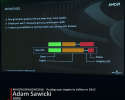Inuhanyou
Veteran
Whether the explanation is devs are lazy, less talented or what have you, I don't like it.@Inuhanyou I don’t think devs are lazy. There’s obviously a knowledge gap. I’d blame internal training more than anything. If you have CS grads entering an industry that don’t have experience with best practices and profiling, you have to teach them. I’m the case of Jedi survivor the issue is allocating memory in the render thread. That just shouldn’t happen. Should have been found in code review, in profiling. People should know not to do that. Doesn’t make sense that no one noticed. It’s an engine architecture problem. It’s not at the level of the publisher. It’s at the level of the developers. The whole thing is very strange.
There's no reason for that to be the conclusion when the blame is always going to be higher up. Like you said it could be training for certain situations, the right leadership properly advising teams to solve problems efficiently, the right production schedule allowing for devs to study and address issues before launch etc
It's clear none of this is happening now

